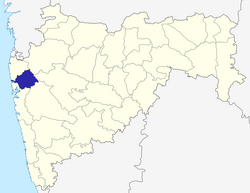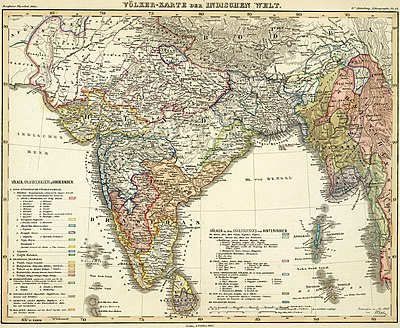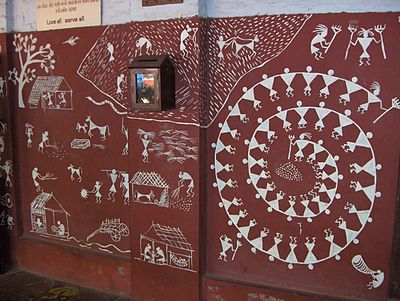Warli tribe and their tribal art
The Warlis or Varlis are an indigenous tribe or Adivasis, living in the mountainous and coastal areas of Maharashtra-Gujarat border and surrounding areas.They have their own animistic beliefs, customs and traditions, however, as a result of acculturation they have also adopted many Hindu beliefs. The Warlis speak an unwritten Varli language which belongs to the southern zone of the Indo-Aryan languages[1][2]. The Warli people are famous for their beautiful and unique style of painting which reflects the close association between human communities and nature.
Contents
History of the Warli tribe
In the 3rd century BCE, a Greek ethnographer named Megasthenes traveled to India as an ambassador to the court of Chandragupta Maurya. His writings talk of an area called Varalata around the present day Dharampur near Thane district of Maharashtra. Some scholars think that this is where the Warli people are derived from, and that their association with their current home goes back at least 2300 years into the past[3]. In 1885, a British government reports mentions the Warlis in the are near Mokhada, in a very deprecating manner:
The inhabitants are Warlis, members of one of the wildest aboriginal tribes in Thana District, who lead a nomadic life, constantly wandering from place to place, and deserting their habitations at a moment's notice for superstitious reasons, whose mode of cultivation is of the rudest description, and all whose ways and habits are of the most primitive character... [RDV 147 of 1885:458].
When the British started ruling the land, they forced many of these tribes, which practiced shifting agriculture, to settle in one place. Their goal was to make the region around Thane, which is quite barren, more tillable and productive.
The extreme north was very wild, the hills were covered with unbroken forest, and the valleys were overgrown with grass. Along the coast, between Umbargaon and Dahanu, were large groves of brab-palms, and further north, near Maroli, the country abounded in teak of a prodigious size, several of the trees measuring over twelve feet in girth and not less than eighty feet high... The country was poorly peopled and badly tilled [Hove, cited in Gazetteer 1882:510].
In 1815, the collector of Salsette was proposing the following, without regard to how the tribals would feel about abandoning their centuries old practices and getting accustomed to the colonial rule:
If by a wise measure of government the labour of this large body of people could be diverted to the cultivation of land: if from a state bordering on brutality they could be converted to useful members of socicty...the long desired wish of the Hon'ble Company to increase'the cultivation of land would be most materially promoted [TFD 764 of 181:72].
The Warlis were, in mid 19th century, then forced to settle down and start cultivating. However, the Britishers' plans did not go as easily as expected. A PhD student KJ Save who was researching the history of the Warli tribe, said this of the Warli people in his 1935 doctoral thesis[4]:
A Warli loathes steady work. From time immemorial they had to work very little and the result of this is that laziness has been the trait of the tribe. He does not take pains during the summer either to level his field or to construct proper bunds for the same. A Warli does not possess his ownbullocks. The quality of the seeds is not fine. The fields are not properly ploughed. All these factors combined, bring a meagre crop to him. The pitiable thing is that a Warli does not realise this. He is satisfied with whatever little he gets which has made him most unambitious and checked his very progress [Save 1945: 203].
The British needed a lot of wood, not just for building homes, bridges and railroads in India but mostly for economic activity back home. This led to a drastic change in the millenia old concept of forest ownership. Ever since the beginning of civilization in India, forest was always considered a community resource. It was the home for several tribes. Now, the British controlled access to these forests. Tribals were forced to move out. The British also brought in the system of landlords. Upper castes, who were rich, got to own their piece of land while the tribals, who now had no means of subsistence, were forced to work as menial labor in the farms owned by the landlords and the British. Although caste system had been operating in India for the last several centuries, the exodus of tribals from the forests, who previously had dignity in their own communities, were now forced to serve in the lowest rung of the society[3].
Tenants of land in the vast jungle tracts of the district are entirely dependent on their landlords not only for lands to cultivate, without which they would starve, but also for their maintenance during not less than five months in the year. Their very homes are as a rule scattered on their landlord's fields and they may at any time be ordered to remove their huts. As I have already stated they cannot feed themselves on their share of their produce longer than until March. Therefore they must rely on their earllings by casual labour, i e, four annas a day, on such days as they are free to work for themselves, and on khawti advances taken in kind from their landlord. From the break of the rains until the rice harvest these khawti advances are their only source of maintenance [Symington 1939: 8].

After the British left in 1947, the remnants of the Warli culture continued its existence in the forests and villages in Thane district. They were soon contacted by the Communist Party of India, which tried to mobilize the community into a revolt against the government, which the CPI painted as an outsider and an exploiter.
The experience of the bitter struggle through which the 'Varli' had to wade had rapidly, transformed him. His transformation had been so radical that he became a new being. He had been quite an innocent infant in understanding and consciousness. Straight from infancy he stepped into maturity. He has advanced with a breathless speed to overtake the peasants who had been far ahead of him by omitting many an intermediary step. He had developed a thirst for knowledge. He had become very keen to know all about Soviet Russia [Parulekar 1979: 582].
However, the influence of the CPI slowly waded. Government as well as non-governmental agencies then came in to help the Warli community. Organizations like the Vanvasi Kalyan Ashram have done some fantastic work in the tribal Warli community over the past few decades in the areas of education and healthcare.
The Warli tribe rose to prominence on a national and an international scale, though, only in the 1970s. The Government of India had sent some officials over to document Warli art. The officials were amazed by the drawings of one Jivya Soma Mashe, who was very prodigal in drawing Warli drawings. While traditional Warli art was being drawn only for ceremonial occasions, Jivya Soma Mashe, who loved drawing and showed an immense understanding of the Warli culture, had started doing that on an every day basis. His art was slowly brought to national and international recognition through the efforts of various agencies, NGOs and businesses. Jivya Soma Mashe won the Padmashree from the Government of India in 2010 in recognition for his contribution towards the arts of India.
Warli beliefs and art
The Warli art stems from their animistic belief system shaped by their centuries old subsistence on forest land. The Warlis did not have a written word until recent times and their art was a way to transmit their belief systems from one generation to the next. Their drawings revolve around the traditions of their communities, the tools they use and their association with nature. Themes include community dances, the harvest as well as "fields swaying with healthy crops, birds flying in the sky, group dancing around a person playing the music, dancing peacocks, women cooking or busy in their other house chores and children playing." [5]
The following section from Wikipedia talks about the intricacies of the Warli form of art[6].
In her book The Painted World of the Warlis Yashodhara Dalmia claimed that the Warlis carry on a tradition stretching back to 2500 or 3000 BCE. Their mural paintings are similar to those done between 500 and 10,000 BCE in the Rock Shelters of Bhimbetka, in Madhya Pradesh.
Their extremely rudimentary wall paintings use a very basic graphic vocabulary: a circle, a triangle and a square.Their paintings were monosyllabic. The circle and triangle come from their observation of nature, the circle representing the sun and the moon, the triangle derived from mountains and pointed trees. Only the square seems to obey a different logic and seems to be a human invention, indicating a sacred enclosure or a piece of land. So the central motive in each ritual painting is the square, known as the "chauk" or "chaukat", mostly of two types: Devchauk and Lagnachauk. Inside a Devchauk, we find Palaghata, the mother goddess, symbolizing fertility. Significantly, male gods are unusual among the Warli and are frequently related to spirits which have taken human shape.
The central motif in these ritual paintings is surrounded by scenes portraying hunting, fishing and farming, festivals and dances, trees and animals. Human and animal bodies are represented by two triangles joined at the tip; the upper triangle depicts the trunk and the lower triangle the pelvis. Their precarious equilibrium symbolizes the balance of the universe, and of the couple, and has the practical and amusing advantage of animating the bodies.
The pared down pictorial language is matched by a rudimentary technique. The ritual paintings are usually done inside the huts. The walls are made of a mixture of branches, earth and cow dung, making a red ochre background for the wall paintings. The Warli use only white for their paintings. Their white pigment is a mixture of rice paste and water with gum as a binding. They use a bamboo stick chewed at the end to make it as supple as a paintbrush. The wall paintings are done only for special occasions such as weddings or harvests. The lack of regular artistic activity explains the very crude style of their paintings, which were the preserve of the womenfolk until the late 1970s
Other media
| About the Warli people | A Warli motion film |
|---|---|
| About Jivya Soma Mashe | |
External links
- A site dedicated to Warli Art Also offers authentic Warli pieces for sale
- Warli and other folk arts of India Another e-shopping site from where you can buy some art pieces
- Warli Painting blog
References
- ^ Kumar Suresh Singh, Rajendra Behari Lal, Anthropological Survey of India (2003). Gujarat, Part 3. 1597 pages (see page:1431-1438): Popular Prakashan. ISBN 81-7991-106-3, 9788179911068.
- ^ Wikipedia article on Warlis
- ^ a b Warli Social History, an Introduction Economic and Political Weekly, 2000
- ^ Research in Sociology
- ^ The Warli from Maharashtra
- ^ Warli painting article on Wikipedia Accessed: September 29, 2012
Comments
blog comments powered by DisqusMore notes like this
| |||||||||||||||||||||||||||||||||||||||||||||||||||||||||||||||||||||||||||||||||||||
Only 15 articles are shown in this list. A total of 64 articles in the database as of this moment. For the complete list, click on further results on the bottom right corner of the above table.
Semantic tags
- Browse all Semantic Tags associated with this page
- Find more pages and articles created by the community by clicking this link.
| Title | Warli tribe and their tribal art | Article is on this general topic | Tribal mythology | Author | Gaurav Moghe |
|---|---|---|---|---|---|
| Specific location(s) where study was conducted | Not noted | General region where study was conducted | Not noted | State where study was conducted | Pan-India |
| Institutional affiliation | Not noted | Institution located at | Not noted | Institution based around | Not noted |
| Species Group | Not noted | User ID | User:Gauravm | Page creation date | 2012/09/13 |
Share this page:


